Audit and Corporate Governance: Analyzing and Reducing the Audit Gap
VerifiedAdded on 2020/03/01
|10
|2267
|45
Essay
AI Summary
This essay delves into the concept of the audit expectation gap, which arises from the disparity between the public's and financial statement users' expectations of auditors and the auditors' perceived responsibilities. It explores various methods to reduce this gap, including the implementation of expanded audit reports, which provide more detailed financial information; education to enhance users' understanding of audit processes; and the adoption of structured audit methodologies to reduce auditors' legal liabilities. The essay also examines the auditor's responsibilities, emphasizing the need for auditors to render opinions on the fairness of financial statements and to adhere to auditing standards. Furthermore, it underscores the importance of expanding auditor responsibilities, particularly in fraud detection, and enhancing auditor independence to narrow the audit expectation gap. The conclusion reinforces the significance of these strategies in improving the audit process and ensuring that the public understands the role of auditors.
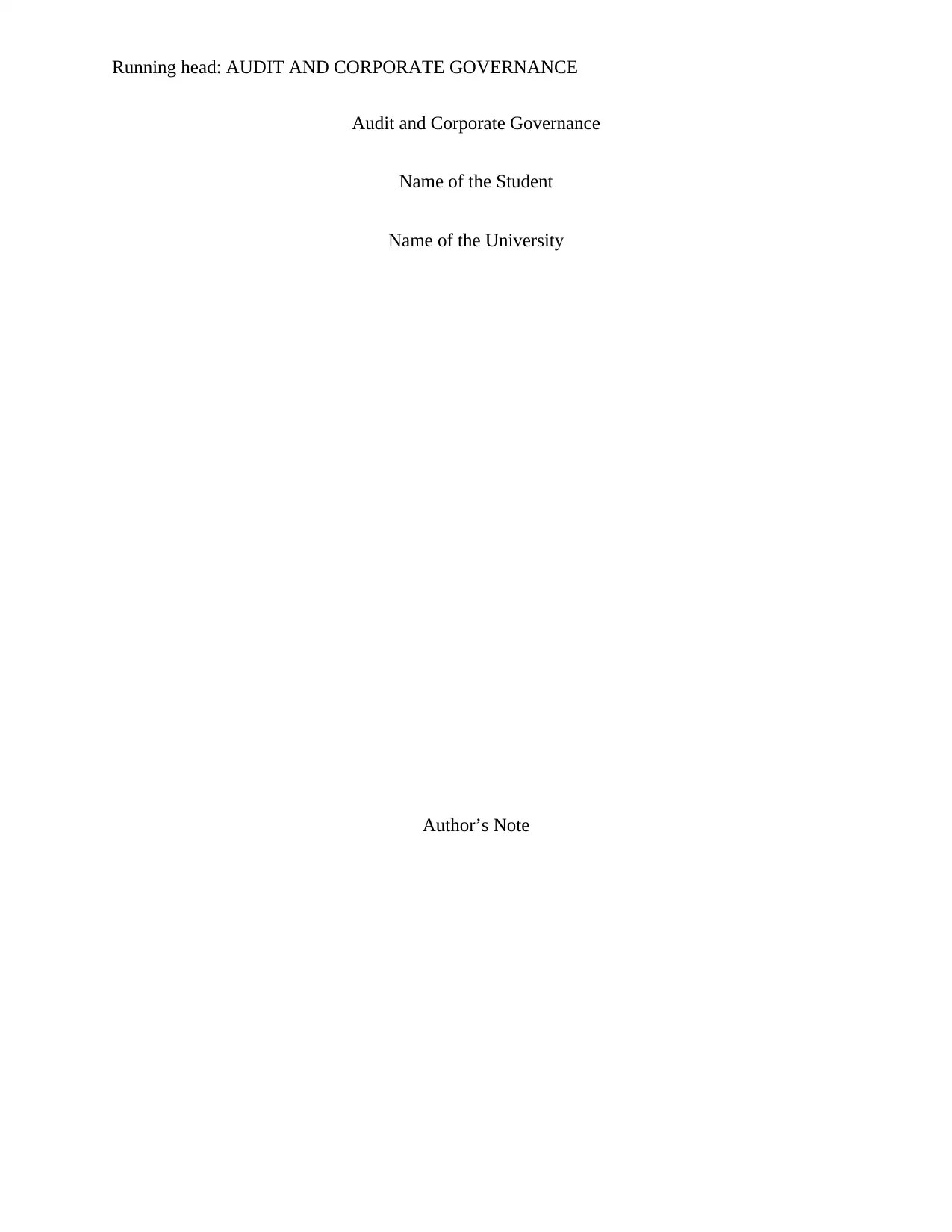
Running head: AUDIT AND CORPORATE GOVERNANCE
Audit and Corporate Governance
Name of the Student
Name of the University
Author’s Note
Audit and Corporate Governance
Name of the Student
Name of the University
Author’s Note
Paraphrase This Document
Need a fresh take? Get an instant paraphrase of this document with our AI Paraphraser
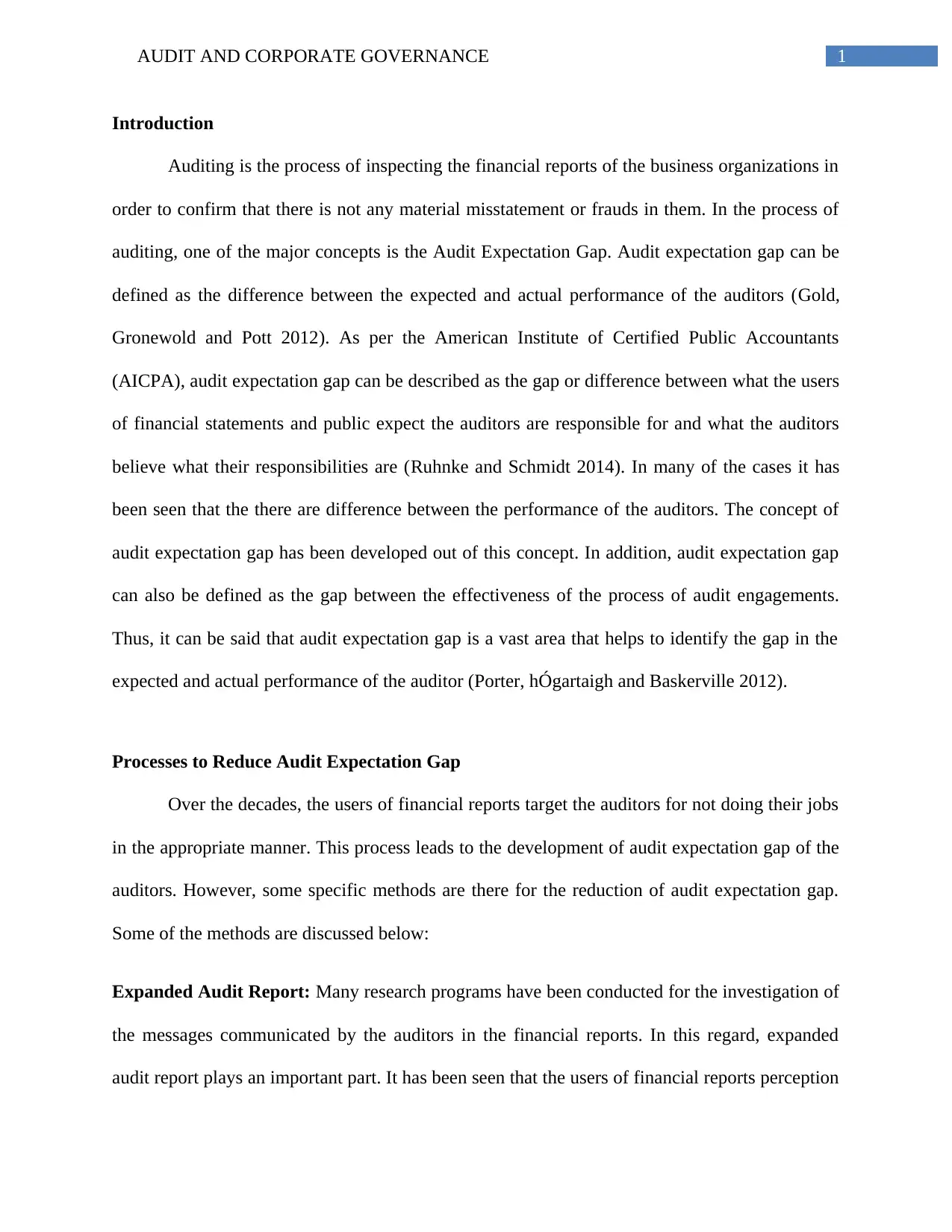
1AUDIT AND CORPORATE GOVERNANCE
Introduction
Auditing is the process of inspecting the financial reports of the business organizations in
order to confirm that there is not any material misstatement or frauds in them. In the process of
auditing, one of the major concepts is the Audit Expectation Gap. Audit expectation gap can be
defined as the difference between the expected and actual performance of the auditors (Gold,
Gronewold and Pott 2012). As per the American Institute of Certified Public Accountants
(AICPA), audit expectation gap can be described as the gap or difference between what the users
of financial statements and public expect the auditors are responsible for and what the auditors
believe what their responsibilities are (Ruhnke and Schmidt 2014). In many of the cases it has
been seen that the there are difference between the performance of the auditors. The concept of
audit expectation gap has been developed out of this concept. In addition, audit expectation gap
can also be defined as the gap between the effectiveness of the process of audit engagements.
Thus, it can be said that audit expectation gap is a vast area that helps to identify the gap in the
expected and actual performance of the auditor (Porter, hÓgartaigh and Baskerville 2012).
Processes to Reduce Audit Expectation Gap
Over the decades, the users of financial reports target the auditors for not doing their jobs
in the appropriate manner. This process leads to the development of audit expectation gap of the
auditors. However, some specific methods are there for the reduction of audit expectation gap.
Some of the methods are discussed below:
Expanded Audit Report: Many research programs have been conducted for the investigation of
the messages communicated by the auditors in the financial reports. In this regard, expanded
audit report plays an important part. It has been seen that the users of financial reports perception
Introduction
Auditing is the process of inspecting the financial reports of the business organizations in
order to confirm that there is not any material misstatement or frauds in them. In the process of
auditing, one of the major concepts is the Audit Expectation Gap. Audit expectation gap can be
defined as the difference between the expected and actual performance of the auditors (Gold,
Gronewold and Pott 2012). As per the American Institute of Certified Public Accountants
(AICPA), audit expectation gap can be described as the gap or difference between what the users
of financial statements and public expect the auditors are responsible for and what the auditors
believe what their responsibilities are (Ruhnke and Schmidt 2014). In many of the cases it has
been seen that the there are difference between the performance of the auditors. The concept of
audit expectation gap has been developed out of this concept. In addition, audit expectation gap
can also be defined as the gap between the effectiveness of the process of audit engagements.
Thus, it can be said that audit expectation gap is a vast area that helps to identify the gap in the
expected and actual performance of the auditor (Porter, hÓgartaigh and Baskerville 2012).
Processes to Reduce Audit Expectation Gap
Over the decades, the users of financial reports target the auditors for not doing their jobs
in the appropriate manner. This process leads to the development of audit expectation gap of the
auditors. However, some specific methods are there for the reduction of audit expectation gap.
Some of the methods are discussed below:
Expanded Audit Report: Many research programs have been conducted for the investigation of
the messages communicated by the auditors in the financial reports. In this regard, expanded
audit report plays an important part. It has been seen that the users of financial reports perception
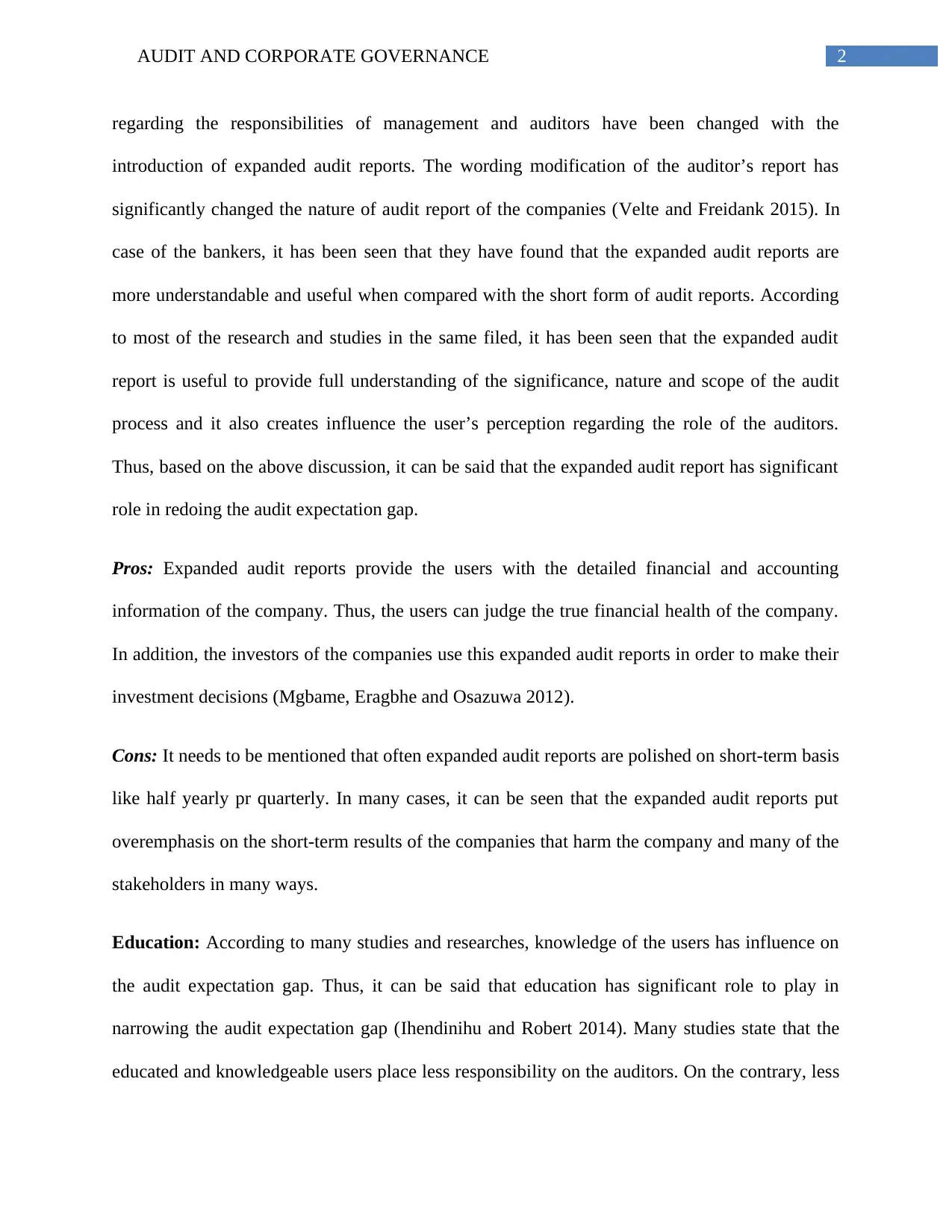
2AUDIT AND CORPORATE GOVERNANCE
regarding the responsibilities of management and auditors have been changed with the
introduction of expanded audit reports. The wording modification of the auditor’s report has
significantly changed the nature of audit report of the companies (Velte and Freidank 2015). In
case of the bankers, it has been seen that they have found that the expanded audit reports are
more understandable and useful when compared with the short form of audit reports. According
to most of the research and studies in the same filed, it has been seen that the expanded audit
report is useful to provide full understanding of the significance, nature and scope of the audit
process and it also creates influence the user’s perception regarding the role of the auditors.
Thus, based on the above discussion, it can be said that the expanded audit report has significant
role in redoing the audit expectation gap.
Pros: Expanded audit reports provide the users with the detailed financial and accounting
information of the company. Thus, the users can judge the true financial health of the company.
In addition, the investors of the companies use this expanded audit reports in order to make their
investment decisions (Mgbame, Eragbhe and Osazuwa 2012).
Cons: It needs to be mentioned that often expanded audit reports are polished on short-term basis
like half yearly pr quarterly. In many cases, it can be seen that the expanded audit reports put
overemphasis on the short-term results of the companies that harm the company and many of the
stakeholders in many ways.
Education: According to many studies and researches, knowledge of the users has influence on
the audit expectation gap. Thus, it can be said that education has significant role to play in
narrowing the audit expectation gap (Ihendinihu and Robert 2014). Many studies state that the
educated and knowledgeable users place less responsibility on the auditors. On the contrary, less
regarding the responsibilities of management and auditors have been changed with the
introduction of expanded audit reports. The wording modification of the auditor’s report has
significantly changed the nature of audit report of the companies (Velte and Freidank 2015). In
case of the bankers, it has been seen that they have found that the expanded audit reports are
more understandable and useful when compared with the short form of audit reports. According
to most of the research and studies in the same filed, it has been seen that the expanded audit
report is useful to provide full understanding of the significance, nature and scope of the audit
process and it also creates influence the user’s perception regarding the role of the auditors.
Thus, based on the above discussion, it can be said that the expanded audit report has significant
role in redoing the audit expectation gap.
Pros: Expanded audit reports provide the users with the detailed financial and accounting
information of the company. Thus, the users can judge the true financial health of the company.
In addition, the investors of the companies use this expanded audit reports in order to make their
investment decisions (Mgbame, Eragbhe and Osazuwa 2012).
Cons: It needs to be mentioned that often expanded audit reports are polished on short-term basis
like half yearly pr quarterly. In many cases, it can be seen that the expanded audit reports put
overemphasis on the short-term results of the companies that harm the company and many of the
stakeholders in many ways.
Education: According to many studies and researches, knowledge of the users has influence on
the audit expectation gap. Thus, it can be said that education has significant role to play in
narrowing the audit expectation gap (Ihendinihu and Robert 2014). Many studies state that the
educated and knowledgeable users place less responsibility on the auditors. On the contrary, less
⊘ This is a preview!⊘
Do you want full access?
Subscribe today to unlock all pages.

Trusted by 1+ million students worldwide
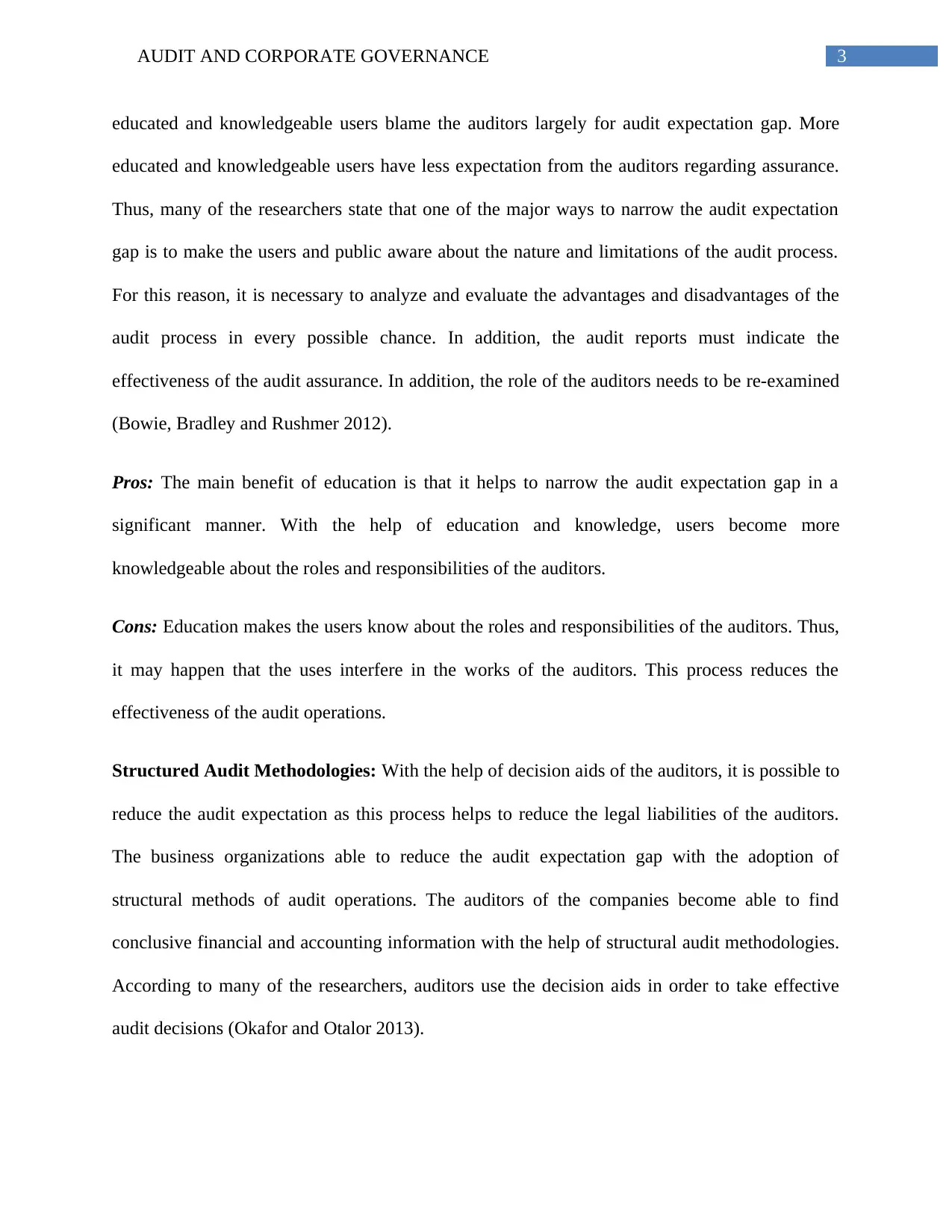
3AUDIT AND CORPORATE GOVERNANCE
educated and knowledgeable users blame the auditors largely for audit expectation gap. More
educated and knowledgeable users have less expectation from the auditors regarding assurance.
Thus, many of the researchers state that one of the major ways to narrow the audit expectation
gap is to make the users and public aware about the nature and limitations of the audit process.
For this reason, it is necessary to analyze and evaluate the advantages and disadvantages of the
audit process in every possible chance. In addition, the audit reports must indicate the
effectiveness of the audit assurance. In addition, the role of the auditors needs to be re-examined
(Bowie, Bradley and Rushmer 2012).
Pros: The main benefit of education is that it helps to narrow the audit expectation gap in a
significant manner. With the help of education and knowledge, users become more
knowledgeable about the roles and responsibilities of the auditors.
Cons: Education makes the users know about the roles and responsibilities of the auditors. Thus,
it may happen that the uses interfere in the works of the auditors. This process reduces the
effectiveness of the audit operations.
Structured Audit Methodologies: With the help of decision aids of the auditors, it is possible to
reduce the audit expectation as this process helps to reduce the legal liabilities of the auditors.
The business organizations able to reduce the audit expectation gap with the adoption of
structural methods of audit operations. The auditors of the companies become able to find
conclusive financial and accounting information with the help of structural audit methodologies.
According to many of the researchers, auditors use the decision aids in order to take effective
audit decisions (Okafor and Otalor 2013).
educated and knowledgeable users blame the auditors largely for audit expectation gap. More
educated and knowledgeable users have less expectation from the auditors regarding assurance.
Thus, many of the researchers state that one of the major ways to narrow the audit expectation
gap is to make the users and public aware about the nature and limitations of the audit process.
For this reason, it is necessary to analyze and evaluate the advantages and disadvantages of the
audit process in every possible chance. In addition, the audit reports must indicate the
effectiveness of the audit assurance. In addition, the role of the auditors needs to be re-examined
(Bowie, Bradley and Rushmer 2012).
Pros: The main benefit of education is that it helps to narrow the audit expectation gap in a
significant manner. With the help of education and knowledge, users become more
knowledgeable about the roles and responsibilities of the auditors.
Cons: Education makes the users know about the roles and responsibilities of the auditors. Thus,
it may happen that the uses interfere in the works of the auditors. This process reduces the
effectiveness of the audit operations.
Structured Audit Methodologies: With the help of decision aids of the auditors, it is possible to
reduce the audit expectation as this process helps to reduce the legal liabilities of the auditors.
The business organizations able to reduce the audit expectation gap with the adoption of
structural methods of audit operations. The auditors of the companies become able to find
conclusive financial and accounting information with the help of structural audit methodologies.
According to many of the researchers, auditors use the decision aids in order to take effective
audit decisions (Okafor and Otalor 2013).
Paraphrase This Document
Need a fresh take? Get an instant paraphrase of this document with our AI Paraphraser
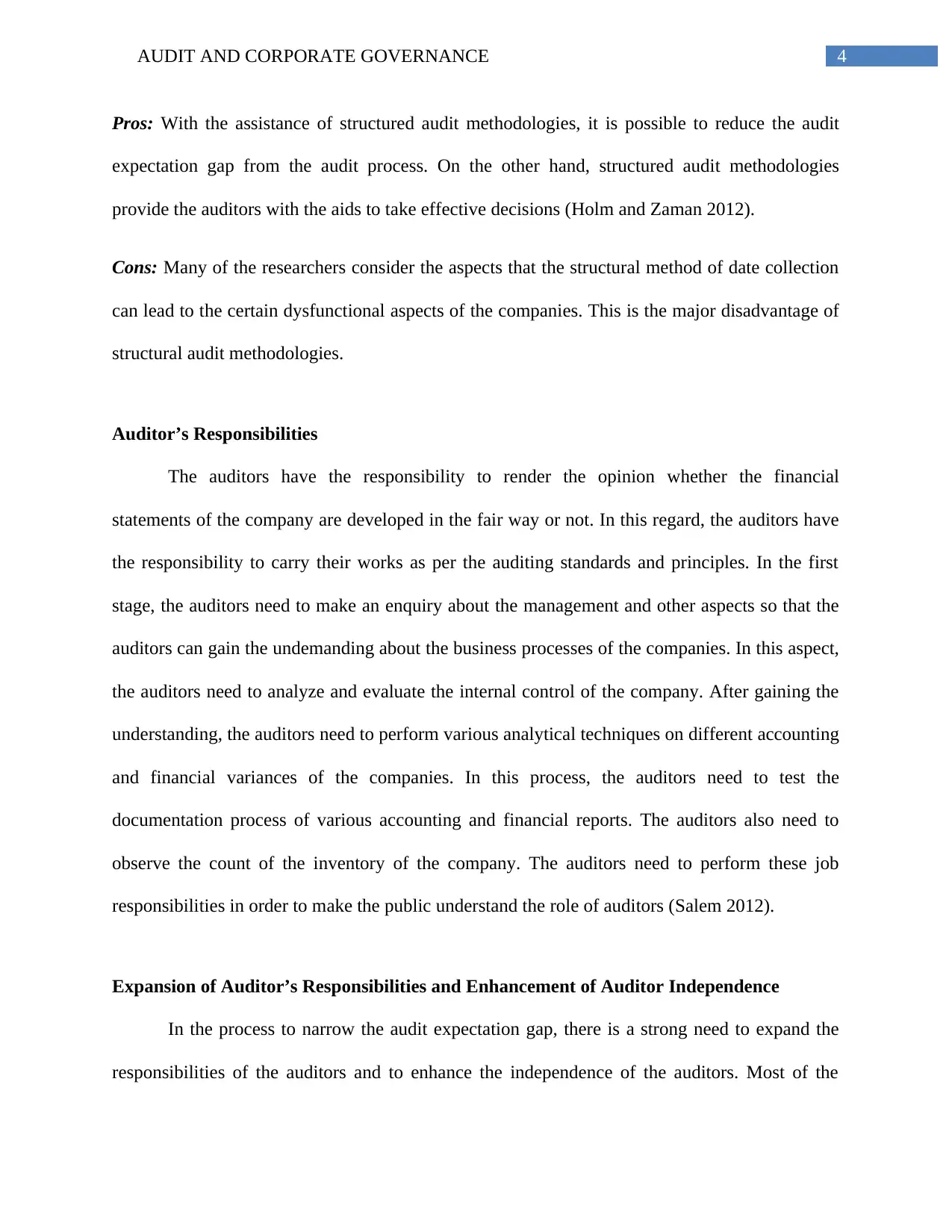
4AUDIT AND CORPORATE GOVERNANCE
Pros: With the assistance of structured audit methodologies, it is possible to reduce the audit
expectation gap from the audit process. On the other hand, structured audit methodologies
provide the auditors with the aids to take effective decisions (Holm and Zaman 2012).
Cons: Many of the researchers consider the aspects that the structural method of date collection
can lead to the certain dysfunctional aspects of the companies. This is the major disadvantage of
structural audit methodologies.
Auditor’s Responsibilities
The auditors have the responsibility to render the opinion whether the financial
statements of the company are developed in the fair way or not. In this regard, the auditors have
the responsibility to carry their works as per the auditing standards and principles. In the first
stage, the auditors need to make an enquiry about the management and other aspects so that the
auditors can gain the undemanding about the business processes of the companies. In this aspect,
the auditors need to analyze and evaluate the internal control of the company. After gaining the
understanding, the auditors need to perform various analytical techniques on different accounting
and financial variances of the companies. In this process, the auditors need to test the
documentation process of various accounting and financial reports. The auditors also need to
observe the count of the inventory of the company. The auditors need to perform these job
responsibilities in order to make the public understand the role of auditors (Salem 2012).
Expansion of Auditor’s Responsibilities and Enhancement of Auditor Independence
In the process to narrow the audit expectation gap, there is a strong need to expand the
responsibilities of the auditors and to enhance the independence of the auditors. Most of the
Pros: With the assistance of structured audit methodologies, it is possible to reduce the audit
expectation gap from the audit process. On the other hand, structured audit methodologies
provide the auditors with the aids to take effective decisions (Holm and Zaman 2012).
Cons: Many of the researchers consider the aspects that the structural method of date collection
can lead to the certain dysfunctional aspects of the companies. This is the major disadvantage of
structural audit methodologies.
Auditor’s Responsibilities
The auditors have the responsibility to render the opinion whether the financial
statements of the company are developed in the fair way or not. In this regard, the auditors have
the responsibility to carry their works as per the auditing standards and principles. In the first
stage, the auditors need to make an enquiry about the management and other aspects so that the
auditors can gain the undemanding about the business processes of the companies. In this aspect,
the auditors need to analyze and evaluate the internal control of the company. After gaining the
understanding, the auditors need to perform various analytical techniques on different accounting
and financial variances of the companies. In this process, the auditors need to test the
documentation process of various accounting and financial reports. The auditors also need to
observe the count of the inventory of the company. The auditors need to perform these job
responsibilities in order to make the public understand the role of auditors (Salem 2012).
Expansion of Auditor’s Responsibilities and Enhancement of Auditor Independence
In the process to narrow the audit expectation gap, there is a strong need to expand the
responsibilities of the auditors and to enhance the independence of the auditors. Most of the
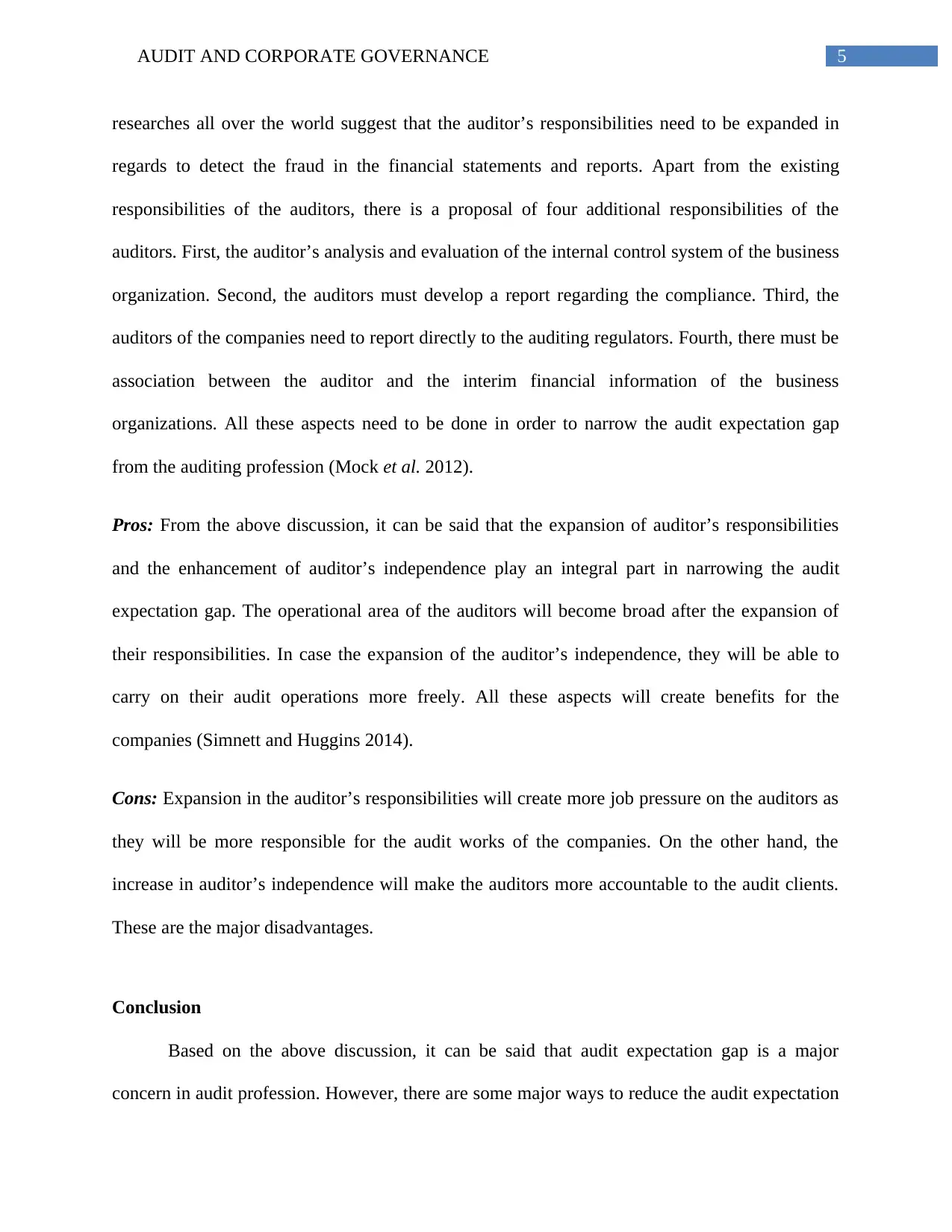
5AUDIT AND CORPORATE GOVERNANCE
researches all over the world suggest that the auditor’s responsibilities need to be expanded in
regards to detect the fraud in the financial statements and reports. Apart from the existing
responsibilities of the auditors, there is a proposal of four additional responsibilities of the
auditors. First, the auditor’s analysis and evaluation of the internal control system of the business
organization. Second, the auditors must develop a report regarding the compliance. Third, the
auditors of the companies need to report directly to the auditing regulators. Fourth, there must be
association between the auditor and the interim financial information of the business
organizations. All these aspects need to be done in order to narrow the audit expectation gap
from the auditing profession (Mock et al. 2012).
Pros: From the above discussion, it can be said that the expansion of auditor’s responsibilities
and the enhancement of auditor’s independence play an integral part in narrowing the audit
expectation gap. The operational area of the auditors will become broad after the expansion of
their responsibilities. In case the expansion of the auditor’s independence, they will be able to
carry on their audit operations more freely. All these aspects will create benefits for the
companies (Simnett and Huggins 2014).
Cons: Expansion in the auditor’s responsibilities will create more job pressure on the auditors as
they will be more responsible for the audit works of the companies. On the other hand, the
increase in auditor’s independence will make the auditors more accountable to the audit clients.
These are the major disadvantages.
Conclusion
Based on the above discussion, it can be said that audit expectation gap is a major
concern in audit profession. However, there are some major ways to reduce the audit expectation
researches all over the world suggest that the auditor’s responsibilities need to be expanded in
regards to detect the fraud in the financial statements and reports. Apart from the existing
responsibilities of the auditors, there is a proposal of four additional responsibilities of the
auditors. First, the auditor’s analysis and evaluation of the internal control system of the business
organization. Second, the auditors must develop a report regarding the compliance. Third, the
auditors of the companies need to report directly to the auditing regulators. Fourth, there must be
association between the auditor and the interim financial information of the business
organizations. All these aspects need to be done in order to narrow the audit expectation gap
from the auditing profession (Mock et al. 2012).
Pros: From the above discussion, it can be said that the expansion of auditor’s responsibilities
and the enhancement of auditor’s independence play an integral part in narrowing the audit
expectation gap. The operational area of the auditors will become broad after the expansion of
their responsibilities. In case the expansion of the auditor’s independence, they will be able to
carry on their audit operations more freely. All these aspects will create benefits for the
companies (Simnett and Huggins 2014).
Cons: Expansion in the auditor’s responsibilities will create more job pressure on the auditors as
they will be more responsible for the audit works of the companies. On the other hand, the
increase in auditor’s independence will make the auditors more accountable to the audit clients.
These are the major disadvantages.
Conclusion
Based on the above discussion, it can be said that audit expectation gap is a major
concern in audit profession. However, there are some major ways to reduce the audit expectation
⊘ This is a preview!⊘
Do you want full access?
Subscribe today to unlock all pages.

Trusted by 1+ million students worldwide
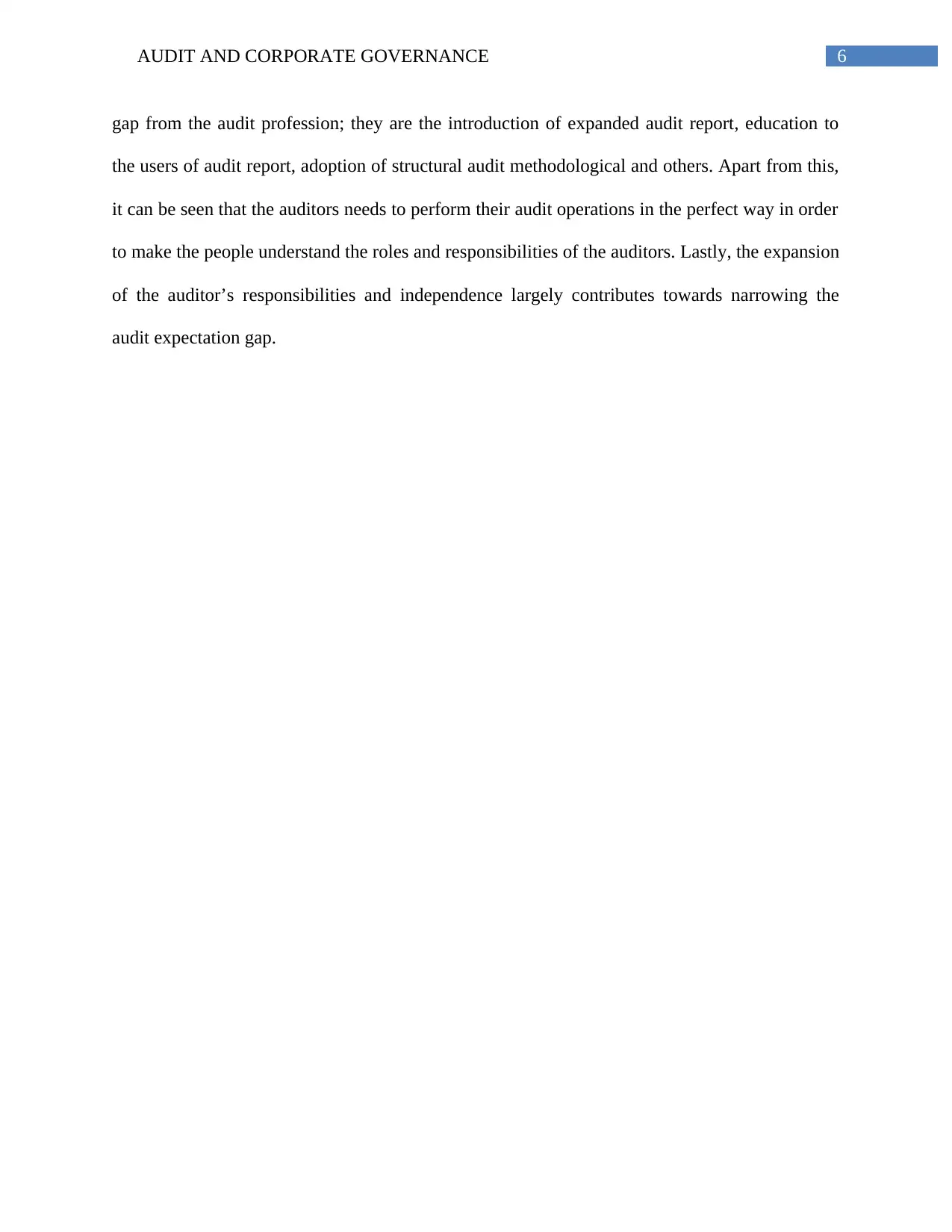
6AUDIT AND CORPORATE GOVERNANCE
gap from the audit profession; they are the introduction of expanded audit report, education to
the users of audit report, adoption of structural audit methodological and others. Apart from this,
it can be seen that the auditors needs to perform their audit operations in the perfect way in order
to make the people understand the roles and responsibilities of the auditors. Lastly, the expansion
of the auditor’s responsibilities and independence largely contributes towards narrowing the
audit expectation gap.
gap from the audit profession; they are the introduction of expanded audit report, education to
the users of audit report, adoption of structural audit methodological and others. Apart from this,
it can be seen that the auditors needs to perform their audit operations in the perfect way in order
to make the people understand the roles and responsibilities of the auditors. Lastly, the expansion
of the auditor’s responsibilities and independence largely contributes towards narrowing the
audit expectation gap.
Paraphrase This Document
Need a fresh take? Get an instant paraphrase of this document with our AI Paraphraser
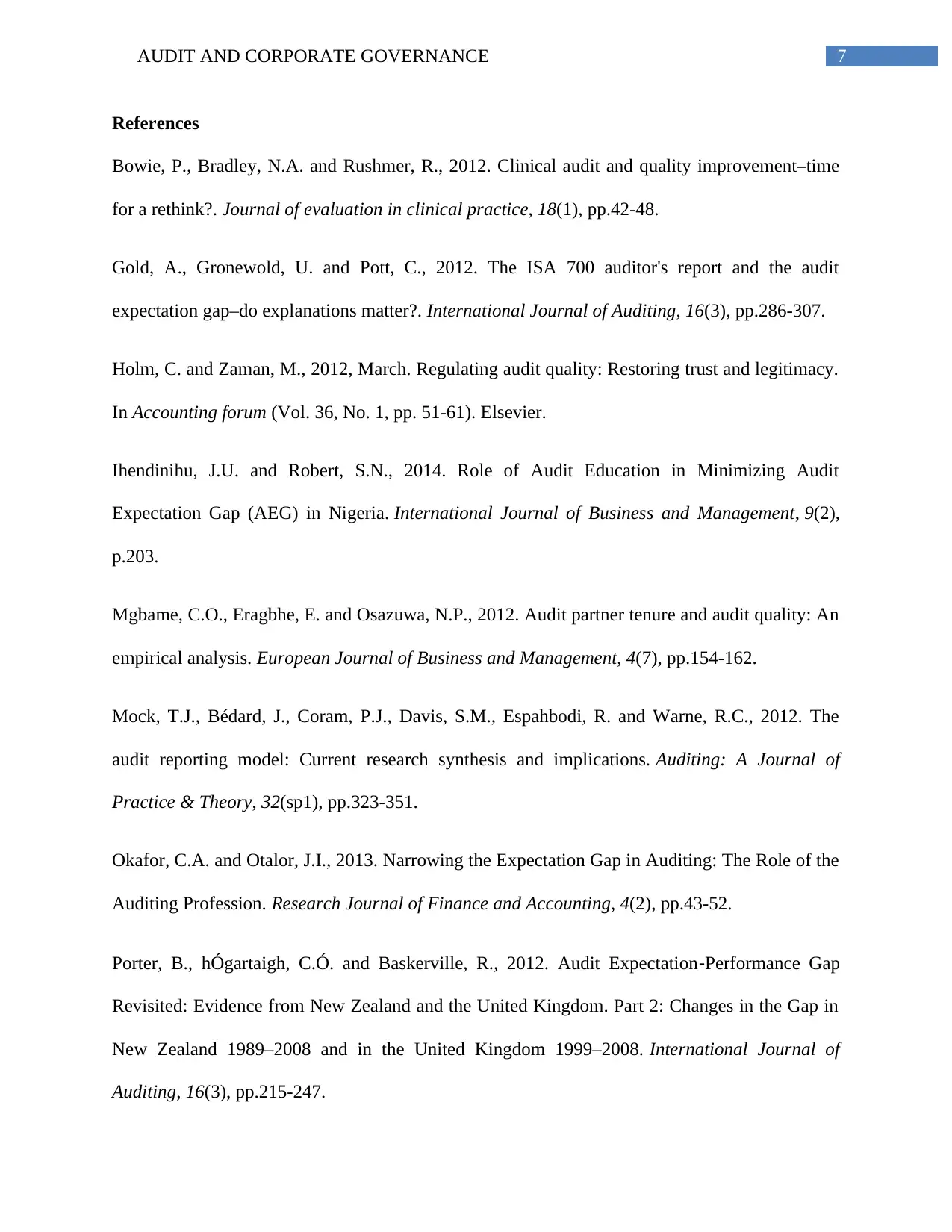
7AUDIT AND CORPORATE GOVERNANCE
References
Bowie, P., Bradley, N.A. and Rushmer, R., 2012. Clinical audit and quality improvement–time
for a rethink?. Journal of evaluation in clinical practice, 18(1), pp.42-48.
Gold, A., Gronewold, U. and Pott, C., 2012. The ISA 700 auditor's report and the audit
expectation gap–do explanations matter?. International Journal of Auditing, 16(3), pp.286-307.
Holm, C. and Zaman, M., 2012, March. Regulating audit quality: Restoring trust and legitimacy.
In Accounting forum (Vol. 36, No. 1, pp. 51-61). Elsevier.
Ihendinihu, J.U. and Robert, S.N., 2014. Role of Audit Education in Minimizing Audit
Expectation Gap (AEG) in Nigeria. International Journal of Business and Management, 9(2),
p.203.
Mgbame, C.O., Eragbhe, E. and Osazuwa, N.P., 2012. Audit partner tenure and audit quality: An
empirical analysis. European Journal of Business and Management, 4(7), pp.154-162.
Mock, T.J., Bédard, J., Coram, P.J., Davis, S.M., Espahbodi, R. and Warne, R.C., 2012. The
audit reporting model: Current research synthesis and implications. Auditing: A Journal of
Practice & Theory, 32(sp1), pp.323-351.
Okafor, C.A. and Otalor, J.I., 2013. Narrowing the Expectation Gap in Auditing: The Role of the
Auditing Profession. Research Journal of Finance and Accounting, 4(2), pp.43-52.
Porter, B., hÓgartaigh, C.Ó. and Baskerville, R., 2012. Audit Expectation‐Performance Gap
Revisited: Evidence from New Zealand and the United Kingdom. Part 2: Changes in the Gap in
New Zealand 1989–2008 and in the United Kingdom 1999–2008. International Journal of
Auditing, 16(3), pp.215-247.
References
Bowie, P., Bradley, N.A. and Rushmer, R., 2012. Clinical audit and quality improvement–time
for a rethink?. Journal of evaluation in clinical practice, 18(1), pp.42-48.
Gold, A., Gronewold, U. and Pott, C., 2012. The ISA 700 auditor's report and the audit
expectation gap–do explanations matter?. International Journal of Auditing, 16(3), pp.286-307.
Holm, C. and Zaman, M., 2012, March. Regulating audit quality: Restoring trust and legitimacy.
In Accounting forum (Vol. 36, No. 1, pp. 51-61). Elsevier.
Ihendinihu, J.U. and Robert, S.N., 2014. Role of Audit Education in Minimizing Audit
Expectation Gap (AEG) in Nigeria. International Journal of Business and Management, 9(2),
p.203.
Mgbame, C.O., Eragbhe, E. and Osazuwa, N.P., 2012. Audit partner tenure and audit quality: An
empirical analysis. European Journal of Business and Management, 4(7), pp.154-162.
Mock, T.J., Bédard, J., Coram, P.J., Davis, S.M., Espahbodi, R. and Warne, R.C., 2012. The
audit reporting model: Current research synthesis and implications. Auditing: A Journal of
Practice & Theory, 32(sp1), pp.323-351.
Okafor, C.A. and Otalor, J.I., 2013. Narrowing the Expectation Gap in Auditing: The Role of the
Auditing Profession. Research Journal of Finance and Accounting, 4(2), pp.43-52.
Porter, B., hÓgartaigh, C.Ó. and Baskerville, R., 2012. Audit Expectation‐Performance Gap
Revisited: Evidence from New Zealand and the United Kingdom. Part 2: Changes in the Gap in
New Zealand 1989–2008 and in the United Kingdom 1999–2008. International Journal of
Auditing, 16(3), pp.215-247.
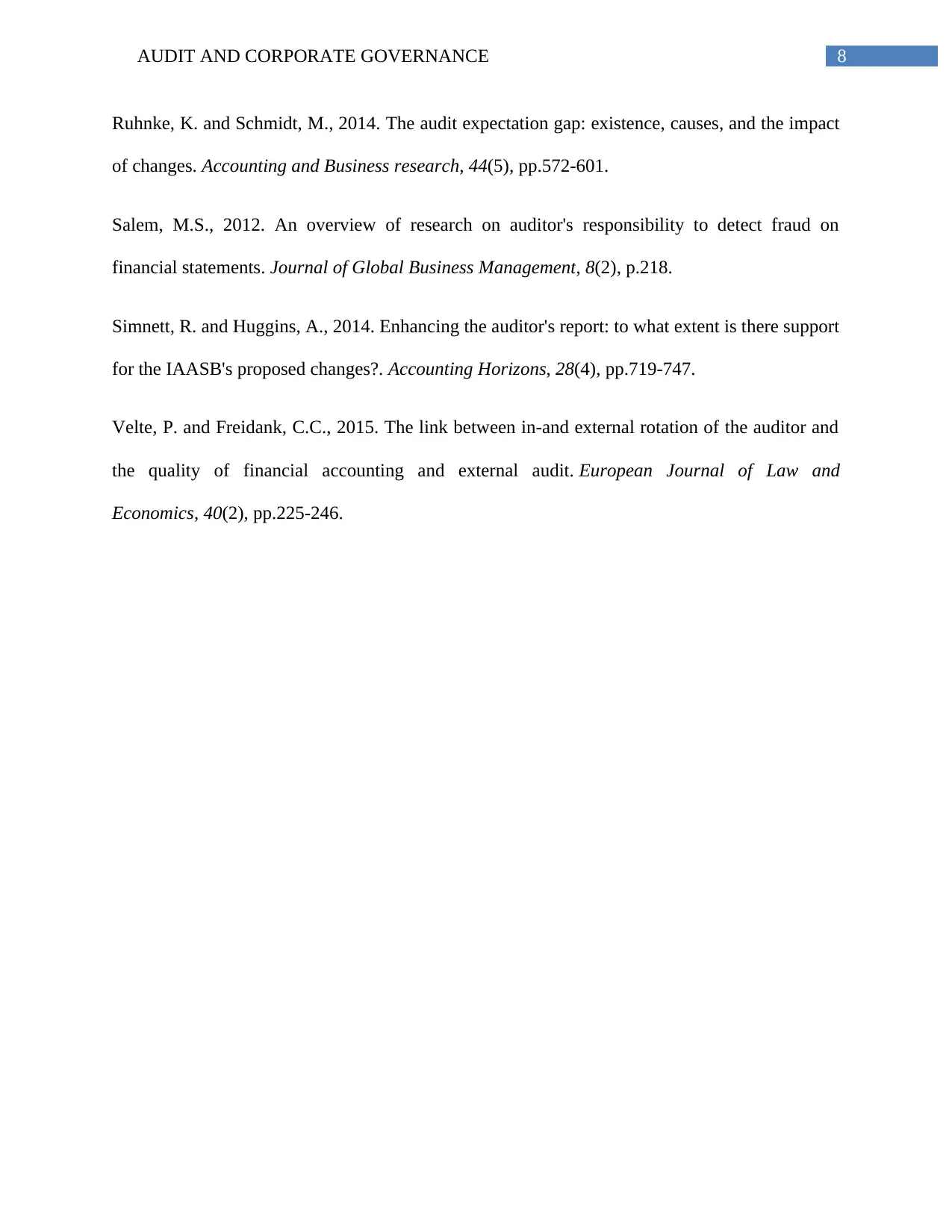
8AUDIT AND CORPORATE GOVERNANCE
Ruhnke, K. and Schmidt, M., 2014. The audit expectation gap: existence, causes, and the impact
of changes. Accounting and Business research, 44(5), pp.572-601.
Salem, M.S., 2012. An overview of research on auditor's responsibility to detect fraud on
financial statements. Journal of Global Business Management, 8(2), p.218.
Simnett, R. and Huggins, A., 2014. Enhancing the auditor's report: to what extent is there support
for the IAASB's proposed changes?. Accounting Horizons, 28(4), pp.719-747.
Velte, P. and Freidank, C.C., 2015. The link between in-and external rotation of the auditor and
the quality of financial accounting and external audit. European Journal of Law and
Economics, 40(2), pp.225-246.
Ruhnke, K. and Schmidt, M., 2014. The audit expectation gap: existence, causes, and the impact
of changes. Accounting and Business research, 44(5), pp.572-601.
Salem, M.S., 2012. An overview of research on auditor's responsibility to detect fraud on
financial statements. Journal of Global Business Management, 8(2), p.218.
Simnett, R. and Huggins, A., 2014. Enhancing the auditor's report: to what extent is there support
for the IAASB's proposed changes?. Accounting Horizons, 28(4), pp.719-747.
Velte, P. and Freidank, C.C., 2015. The link between in-and external rotation of the auditor and
the quality of financial accounting and external audit. European Journal of Law and
Economics, 40(2), pp.225-246.
⊘ This is a preview!⊘
Do you want full access?
Subscribe today to unlock all pages.

Trusted by 1+ million students worldwide
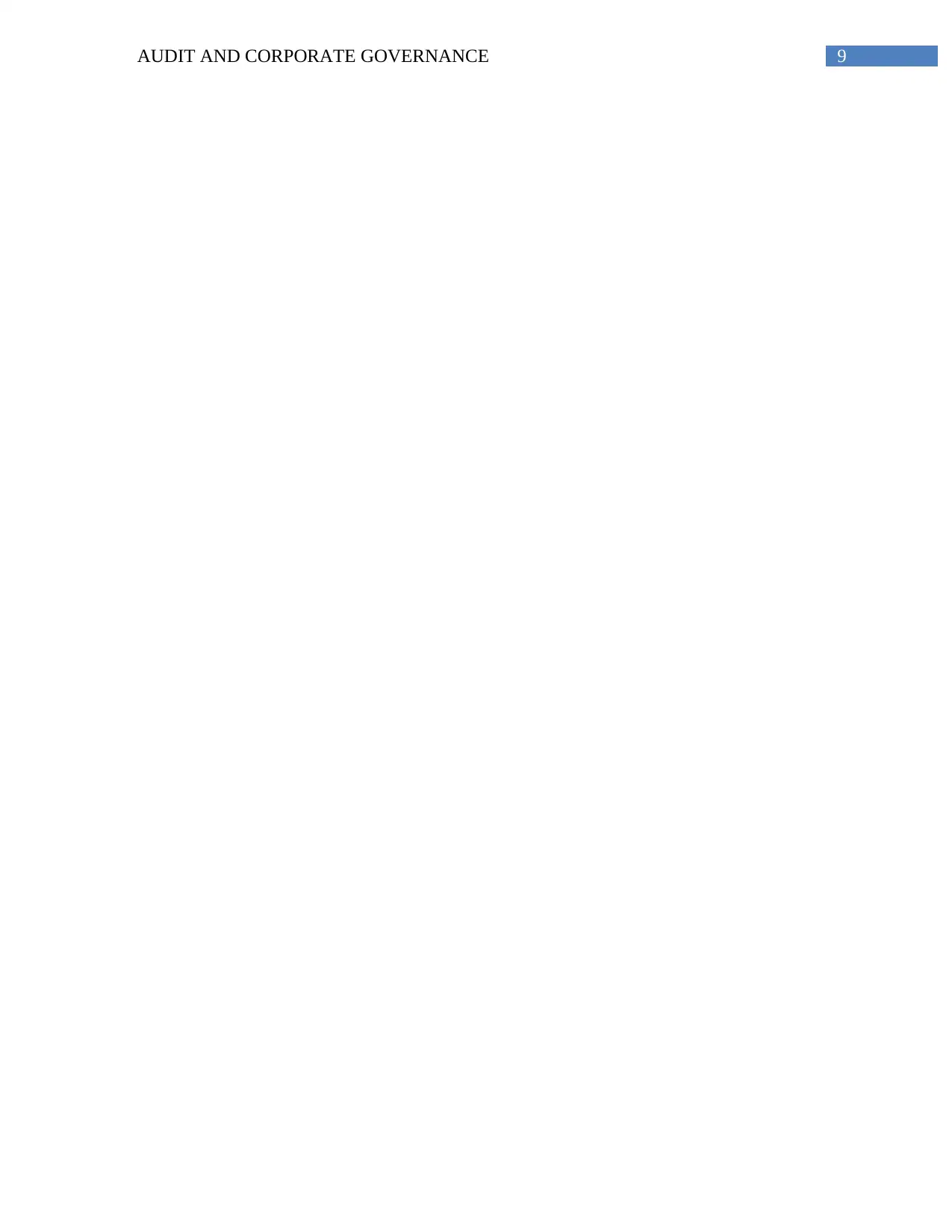
9AUDIT AND CORPORATE GOVERNANCE
1 out of 10
Related Documents
Your All-in-One AI-Powered Toolkit for Academic Success.
+13062052269
info@desklib.com
Available 24*7 on WhatsApp / Email
![[object Object]](/_next/static/media/star-bottom.7253800d.svg)
Unlock your academic potential
Copyright © 2020–2025 A2Z Services. All Rights Reserved. Developed and managed by ZUCOL.





